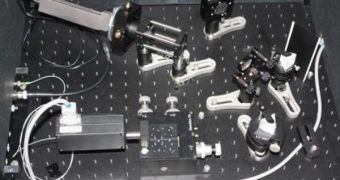Scientists at the National Institute of Standards and Technology (NIST) have recently developed a new method of detecting near-infrared light, an achievement that could have significant repercussions for research fields ranging from quantum communications to astronomy and forensics. In the future, the new, highly sensitive, low-cost method could become an indispensable tool for communications, where infrared frequencies are the most used ones. The technique also has the ability to detect single photons, emitted by nanomaterials and biomaterials.
In a paper published in the August 3rd issue of the respected scientific journal Optics Express, entitled “Experimental study of high sensitivity infrared spectrometer with waveguide-based up-conversion detector,” researchers Lijun Ma, Oliver Slattery and Xiao Tang, all from NIST, describe the basic operating principles of the new spectrometry method. In spectral analysis, having detectors able to pick up the energy of single photons is the ultimate goal for creating ultra-sensitive instruments. Over the last three decades, steady progress has been made in this regard, but it wasn't until now that maximum efficacy was reached, the team writes.
While methods of capturing photons in the visible and ultraviolet wavelengths have progressed constantly over the years, much less success was obtained in infrared wavelengths. The main obstacles that prevented major breakthroughs were either too much static noise, or a heavy reliance on superconducting materials, or even slow and inefficient machines, which took their time in detecting the targeted wavelengths. The NIST group therefore decided to augment an existing observation method, called avalanche photodiode detectors (APD), and make it see infrared as well, in addition to the usual, visible light.
In their efforts, the scientists used the “up-converting” method, which was also created at NIST, some two years ago. In this technique, a strong, tunable laser is employed to bump up a photon's energy. If infrared photons are targeted, then their energies are sufficiently altered to enter the visible spectrum, where they can be more easily detected. If it's applied on visible light photons, they move in the ultraviolet wavelengths, and so on, the researchers explain. The sensitivity that the NIST team obtained with the new tool is about 1,000 times stronger than that found in commercially available, optical, spectral instruments.
“Our key achievement here was to reduce the noise, but our success would not have been possible without the many years of work by others in this field. We hope that our discovery will open doors for researchers studying diseases, pharmaceuticals, secure communications and even solving crimes. We are very excited to make this technology available to the larger scientific community,” Tang concludes.

 14 DAY TRIAL //
14 DAY TRIAL //